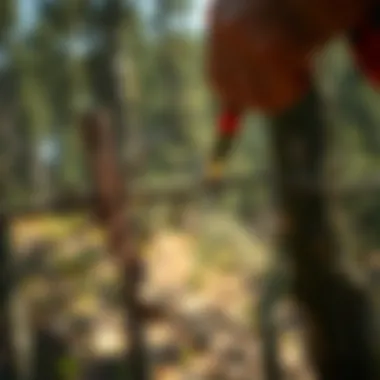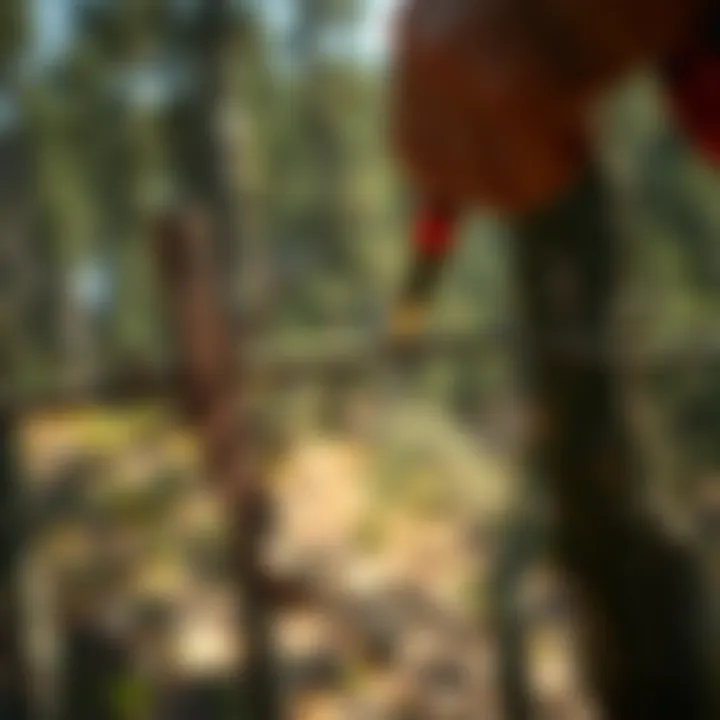Mastering the Art of Pruning Young Trees


Intro
Pruning young trees can often feel like a daunting undertaking, especially for those without much experience in forestry. However, understanding the principles behind effective pruning is crucial for ensuring healthy growth and longevity of these plants. Whether you are a seasoned gardener or a budding enthusiast, grasping the art and science of pruning can be pivotal in shaping the future of trees.
Overview of Forestry Practices
Definition of Forestry
Forestry is the science and art of managing forests, tree plantations, and related resources to meet the comprehensive needs of society in a sustainable manner. It encompasses all the activities that take place in wooded areas, from planting and caring for trees to integrating them into our broader ecosystem and economy. Practitioners of forestry, such as forestry professionals, minimize negative impacts while promoting healthy growth and biodiversity.
Importance of Forestry in Ecosystem Management
The role of forestry in ecosystem management cannot be underestimated. Healthy forests provide essential services such as carbon storage, oxygen production, and habitat for biodiversity. Beyond these environmental benefits, forests also offer economic resources through timber, recreation, and tourism. Managing these resources judiciously is key to balancing human needs with ecological preservation, ensuring that future generations can enjoy the lush environments we have today.
Sustainable Forest Management
Principles of Sustainable Practices
Sustainable forest management is a critical cornerstone of modern forestry practices. It involves ensuring that current forestry activities do not compromise the health of the forest or deplete resources for the future. Key principles include:
- Maintaining Ecosystem Integrity: Safeguarding the entire ecosystem, including soil, water, and wildlife, promotes resilience against diseases and climate variability.
- Adaptive Management: Using scientific research and monitoring helps adjust practices based on what is learned, fostering continuous improvement in management strategies.
- Community Involvement: Engaging local communities in decision-making processes fosters sustainable practices that consider both environmental and socio-economic factors.
Techniques in Sustainable Management
Several techniques can help in achieving sustainable forest management, especially when it comes to young trees:
- Selective Pruning: This method focuses on removing only specific branches to enhance light penetration and air circulation.
- Crop Tree Release: By identifying and supporting key trees in a young forest, managers can encourage stronger growth and health.
- Thinning: This process involves strategically removing trees to reduce competition for resources, promoting the well-being of those that remain.
Woodland Stewardship Strategies
Importance of Woodland Stewardship
Woodland stewardship is about taking responsibility for the health and management of forested land. It is essential for sustaining forests that provide economic and ecological benefits. Stewardship helps in mitigating issues such as soil erosion, invasive species, and inefficient land use.
Best Practices for Landowners
For landowners, there are specific strategies to enhance the stewardship of their woodland areas:
- Regular Assessments: Periodic evaluations of tree health and forest conditions help in identifying problems early.
- Integrated Pest Management: This approach reduces reliance on chemical pesticides, promoting the use of natural controls.
- Education and Training: Staying informed about best practices and emerging techniques can empower landowners to make better decisions.
"Proper care and timely pruning can turn a simple tree into a magnificent feature of a landscape."
In these ways, understanding the principles behind pruning young trees and applying the sustainable practices discussed can lead to thriving, resilient forests.
For further reading, refer to resources such as the U.S. Forest Service, Wikipedia on Forestry, and the National Forest Foundation.
By incorporating these principles into forest management, we can create healthier ecosystems that benefit us all.
Preface to Tree Pruning
Tree pruning, while often overlooked, plays a pivotal role in nurturing the health and structure of young trees. Understanding this practice not only allows tree caretakers to cultivate lush greenery but also opens a dialogue about sustainable forestry. Whether you’re a researcher, a gardener, or someone who appreciates the beauty of trees, familiarizing yourself with pruning practices is essential.
Proper pruning is more than mere aesthetics; it fosters healthy growth, influences how a tree develops over the years, and prevents potential hazards. Creating a solid foundation for young trees during their formative years encourages robust development. Trees are like children, in a way—if they don’t receive the right guidance early on, they may struggle later in life.
From improving air circulation to allowing more sunlight to penetrate the foliage, the benefits of thoughtful pruning extend beyond mere appearance. Engaging with tree trimming ensures not just the vitality of individual trees but also enhances the overall ecosystem. This article serves as a comprehensive guide on pruning methods, touching on various critical aspects that every tree enthusiast should know.
Understanding the Importance of Pruning
Pruning may seem like a straightforward task, but its significance is layered and profound. It’s essential for maintaining the structural integrity of young trees. Without intervention, trees can become overgrown, which might lead to weak branch structures. Over time, this could result in significant safety hazards, such as falling branches or even the entire tree failing. Pruning allows caretakers to manage this growth effectively, redirecting energy towards stronger limbs.
Another vital aspect of pruning is health enhancement. Trimming away dead, diseased, or pest-ridden branches far removes potential threats to the whole tree. This practice of removing unhealthy limbs promotes new growth and minimizes stress on the remaining branches. According to studies from conservation professionals, healthy trees are more resilient to diseases and environmental changes.
Lastly, effective pruning encourages blooming or fruiting in many species. For instance, fruit trees benefit immensely from careful cuts that maximize growth and agricultural yield. Taking the time to learn these techniques not only helps maximize the tree’s potential but also brings joy when witnessing their flourishing results.
Distinct Phases of Tree Growth
Understanding the different phases of tree growth provides context for why pruning is not only beneficial but necessary. Young trees go through stages that set the groundwork for their future. Each stage has unique characteristics and needs that influence how one should approach pruning.
- Establishment Phase:
In the early years, a young tree is establishing its root system. During this time, the focus should be on developing a strong trunk and healthy roots. Pruning may include removing competing leaders or weak branches, guiding the tree to develop a strong central leader. - Development Phase:
As trees mature, they begin to fill out and establish their shape. This is when pruning becomes more about structural integrity and aesthetic appearance. Removing branches that cross each other or threaten to rub against each other can prevent future complications. - Mature Phase:
When trees reach maturity, regular maintenance pruning can help sustain health and beauty. This includes periodic assessments to remove any dead or dying branches and ensure that the tree remains well-structured.
By recognizing the distinct phases of growth, caretakers can tailor their pruning strategies to best suit the tree’s current needs, ensuring long-term health and vitality.
"A little care goes a long way; understanding the rhythms of tree growth opens the door to successful pruning outcomes."
In summary, this article will explore tree pruning's importance, techniques, and strategies that resonate not only with horticulturalists but also forestry professionals committed to effective tree care. The following sections will deepen this understanding, clarifying the science and art of pruning young trees.
Fundamentals of Young Tree Physiology
Understanding the principles behind young tree physiology is key for effective pruning. The health and robustness of any tree start with its fundamental biological processes. Young trees exhibit unique growth characteristics and may react quite differently to pruning compared to older, more established trees. Recognizing these traits can guide tree care strategies to promote healthier, sturdier trees in the long run.
Growth Patterns in Young Trees
Young trees display dynamic growth patterns that are essential to their overall development. When they first sprout, they prioritize vertical growth. The primary goal is to reach sunlight, which might be hindered by competing vegetation. Thus, as a tree matures, the concentration on upward growth shifts towards lateral development, forming a broader canopy and a more balanced structure. This transition usually occurs within the first few years of the tree’s life.


Moreover, young trees tend to grow through what’s called the apical bud dominance phase. Essentially, this means the main stem grows faster than the side branches, leading to a tapered shape. This characteristic often needs managing with strategic pruning to avoid structural weaknesses later on. If you don’t address this early on, you might end up with a tree that leans or develops poorly.
Notably, growth patterns vary significantly by species. For example, a loblolly pine will have markedly different growth habits than a red maple. Understanding these differences can inform pruning strategies, as certain species may respond better to specific cuts or techniques.
Key points about growth patterns:
- Young trees prioritize upward growth to access sunlight.
- Structural growth shifts from vertical to lateral as trees mature.
- Species-specific characteristics influence growth and response to pruning.
How Pruning Affects Development
Pruning is not just about aesthetics; it's a crucial factor in shaping a tree's development. The act of pruning can assist in promoting healthier growth and mitigating potential issues that might arise down the road. When done correctly, it encourages a strong structure and can even enhance flowering and fruiting capabilities.
One of the most significant ways pruning influences a tree is through the regulation of growth hormones. Trees produce auxins, which control growth responses. When you prune away branches, the distribution of these hormones changes, often leading to more robust lateral growth where it's needed. This process can make a tree sturdier overall, a vital consideration that contributes to its resilience against storms and pests.
Furthermore, regular pruning can help manage diseases. By removing dead or diseased branches, you minimize the spread of pathogens that could compromise the entire tree. Notably, the spacing of branches also plays a role in reducing humidity levels within the canopy. A well-pruned tree allows for better air circulation and sunlight penetration, reducing the likelihood of rot and fungal growth.
"A well-pruned tree translates to a resilient tree. With the right techniques, you’re not just trimming for beauty; you’re nurturing its health."
In summary:
- Pruning alters the distribution of growth hormones, improving branch structure.
- Regular pruning can help in disease management and prevention.
- A well-pruned tree promotes better air circulation, thus reducing the risk of rot.
By integrating these physiological concepts into your pruning practices, you set yourself up for success. It is more than just a task; it’s a nurturing process that will shape the future of your trees.
Optimal Timing for Pruning
Choosing the right moment for pruning young trees is not just a matter of preference; it significantly affects the health and growth of the tree. Picking the optimal timing can mean the difference between a robust, thriving tree and one that struggles with disease or improper growth. By understanding the seasonal patterns and indicators, tree caretakers can facilitate better development and promote strong structures for future growth.
Seasonal Considerations
Timing your pruning activities based on the seasons is crucial for maximizing the benefits while minimizing stress on the tree. Each season offers different conditions that influence tree health.
- Winter: Pruning during the dormant season, typically late winter to early spring, is often advisable. Trees are less susceptible to stress and pest infestations when they are not actively growing. This period allows for a clear view of the tree structure and its branches, enabling more precise cuts.
- Spring and Summer: Pruning in these seasons can encourage new growth, but it requires caution. During active growth, trees are filled with sap, which can ooze from cuts, increasing susceptibility to pathogens. However, light pruning can help shape the tree as needed.
- Fall: It's generally best to avoid pruning in late summer and fall. Trees start to prepare for winter, diverting energy into fortifying their roots and branches rather than pushing out new growth. Pruning at this time can hinder their natural processes and may leave them vulnerable to winter damage.
It's widely accepted that pruning young trees in winter, prior to the burst of spring growth, maximizes their potential for a strong start.
Signs Indicating the Right Time to Prune
While seasons provide a framework, being in tune with the tree itself is equally vital. Signs indicating it's time to prune include:
- Leaf Drop: Many deciduous trees shed their leaves in fall, marking a natural time for pruning. Inspect your trees once leaf drop is complete—you'll have a clearer view of the tree’s structure.
- Branch Growth: If branches are crossing or starting to rub against each other, it's an indication they need to be thinned. Removing competeing branches can foster healthier growth patterns.
- Health Issues: If branches appear dead or diseased, it's essential to prune these areas as soon as identified, regardless of the season. This helps protect the tree's overall health and can prevent the spread of any diseases.
- Sap Flow: Observing sap flow can also signal timely pruning. If sap is starting to ooze from previous cuts or along branches, it may be a sign that the tree is actively growing, suggesting a more cautious approach if pruning.
In summary, optimizing your pruning schedule involves understanding both seasonal implications and specific signs from the tree. Pruning at the right time not only supports healthy growth but also enhances the longevity and resilience of young trees.
Essential Tools and Equipment
Having the right tools is a crucial factor when it comes to pruning young trees. It’s not just about having fancy gadgets; it’s about using the right instruments to ensure both the effectiveness of your pruning efforts and the health of the trees. Proper tools can help minimize stress on the tree and foster better recovery post-pruning.
Basic Pruning Tools
When stepping into the realm of tree pruning, understanding the essential tools becomes paramount. Here’s a closer look at the basics that should be in every tree caretaker's arsenal:
- Hand Pruners: These compact and handy tools are ideal for removing small branches and excess growth. Look for bypass pruners which cut with a scissor-like motion,it's better for the tree sap.
- Loppers: For slightly thicker branches, loppers offer more leverage than hand pruners. Their long handles allow users to reach higher points without the strain of ladders.
- Pruning Saws: When you're faced with larger limbs, a pruning saw is indispensable. These saws come in different shapes and sizes; the curved blade design allows for efficient cutting in tight spaces.
- Pole Saws: When the branches are just out of reach, a pole saw can help you tackle those higher areas without having to climb every time.
- Root Pruners: Often overlooked, these specialized tools help in managing root growth, especially important in keeping young trees stable.
Maintaining your tools is another part of the equation. Regular cleaning and sharpening will ensure that the pruning cuts are clean and reduce the risk of injury to the tree.
Safety Equipment for Tree Care
Safety ought to be the first commandment when dealing with trees, especially those with a substantial scale and weight. Implementing good safety practices not only protects you but also leads to better harvesting outcomes in the long run.
Consider donning the following:
- Gloves: Protect your hands from cuts and scrapes. Opt for thick, durable gloves that allow for dexterity yet offer a barrier against sharp branches.
- Safety Glasses: Flying debris can come from nowhere, especially when cutting with saws or loppers. Safety eyewear can prevent injuries in that area of the body.
- Hard Hats: For those working on taller trees or in precarious environments, a hard hat provides a buffer against unexpected falls of branches.
- Harnesses or Lanyards: If your work involves climbing, investing in quality climbing gear is indispensable. These save lives by preventing falls from heights.
- First Aid Kit: While it's not a conventional safety tool, having a first aid kit close at hand can help mitigate minor injuries that inevitably occur during tree care.
Using the right tools with a sound safety mindset not only conserves your time and resources but also lays the foundation for effective tree management.
“Safety isn’t just a slogan, it’s a way of life.”
When these basic tools and safety precautions are combined with well-planned pruning techniques, the result will be healthier trees and a more enjoyable pruning experience.
Pruning Techniques for Young Trees
Pruning young trees isn't just about wielding a pair of shears; it’s a careful art and science that fosters a healthier canopy and a stronger tree. Understanding various pruning techniques can make or break the future development of a tree. The methods applied influence its structural integrity, growth direction, and even overall health for many years to come. Little do many realize, the techniques used today set the tone for how that tree will present itself in decades.


Types of Pruning Cuts
Different cuts serve different purposes, so knowing the types can be invaluable in effecting the desired growth patterns. Here are some primary cuts to consider:
- Heading Cut: Involves cutting a branch to a bud or a smaller branch. This one is effective in promoting bushiness, making trees denser. Just be careful; too many heading cuts can leave a tree looking ragged.
- Thinning Cut: This type removes a branch back to its origin. It reduces the density without drastically changing the tree’s shape. It’s typically a favorite for those wanting to ease wind resistance on their tree's canopy.
- Reduction Cut: This cut lowers the height or spread of a branch, quite strategic if you have overcrowded limbs. It's paramount for maintaining the overall aesthetics and health of the tree.
When applying cuts, make sure to cut above the branch collar—the bulge where the branch meets the trunk. This helps the tree to heal efficiently and can fend off disease.
"Correct cuts can significantly enhance the future growth of a tree while allowing it to recover more easily from any disruptions."
Strategic Branch Removal
Every branch plays a role in the overall growth of a tree, but some may need to go. It’s crucial to assess whether a branch is weak or competing with the leader stem. A badly placed branch can lead to issues down the road, such as structural instability or disease.
Consider these approaches:
- Identify competing leaders: A tree should ideally have one main trunk extending towards the sky. If multiple branches are trying to be the main leader, choose the stronger one and clip the others to lower points.
- Remove dead or diseased branches: Not only do these branches detract from the aesthetics, but they can also serve as entry points for pests. Keeping the tree healthy requires diligence in monitoring its limbs.
- Choose lower branches wisely: If you’re working with young trees, it’s wise to eliminate some lower branches to allow for air circulation and sunlight penetration. This ultimately stimulates better growth higher up the trunk.
With these strategic removals, you don't just enhance the immediate appearance of your tree; you cultivate healthier growth patterns long-term.
Shaping for Aesthetic and Structural Integrity
A well-pruned tree is often a sight for sore eyes. But it's not just about looks; the correct shaping of a tree influences its overall functionality. Getting it right involves a balance between artistic vision and structural needs.
- Consider the tree’s natural form: Trees, like people, have different personalities. Some lean towards being spread out while others are more upright. Pruning should enhance, not alter, the preferred growth pattern.
- Promote symmetry and balance: A tree that’s well-shaped replicates harmony. This means having an even distribution of branches across all sides.
- Think about future growth: Don’t just look at the tree as it stands today. Consider how it will grow in the future. The cuts made today can influence how the branches will develop. Over time, they'll need room to grow larger without being stifled.
In the end, shaping is not merely for aesthetics; it heavily latches onto the longevity and health of the tree, emphasizing a harmonious relationship between beauty and stability.
In sum, focusing on proper pruning techniques is pivotal in nurturing young trees towards their optimal growth path. By applying the right cuts, choosing branches wisely, and shaping for both aesthetics and structural strength, you guide these trees to flourish beautifully into maturity.
Addressing Common Pruning Mistakes
Pruning is often viewed as a straightforward activity, but it can quickly become a bit murky if one isn't aware of common slip-ups that can harm young trees. Addressing common pruning mistakes is crucial, as it can mean the difference between a healthy tree that flourishes and one that flounders. Understanding these pitfalls allows tree caretakers to make educated decisions, ensuring the trees develop strong structures and remain visually appealing. This section will delve into the mistakes people often make while pruning, with a focus on two major errors: over-pruning and under-pruning.
Over-pruning and Its Consequences
Over-pruning, often likened to giving a tree a bad haircut, can be devastating. When too many branches are removed at once, it risks stripping the tree of essential growth. The consequences can be dire, including reduced photosynthesis, leading to weakened overall health.
The most immediate effect of over-pruning is that the tree can struggle to thrive. Without enough foliage, it cannot capture sunlight effectively, which stifles its growth and resilience. In severe cases, over-pruning can even lead to tree death. Some specific signs that a tree may have been over-pruned include:
- Excessive wilting or dying leaves: A tree short on foliage will struggle to maintain its vitality.
- Increased vulnerability to pests: An unhealthy tree becomes a prime target for insects and diseases.
- Uneven growth patterns: Lack of branches can cause the tree to grow unnaturally, resulting in structural issues later on.
Pruners should approach their task with restraint and thoughtfulness, always considering the tree's health before deciding how much to trim. As a rule of thumb, trimming no more than 25% of a tree's branches in a single season is generally advised. This helps in maintaining balance and allowing the tree to recover from any cuts.
Under-pruning: When Not Enough is Done
Conversely, under-pruning presents its own set of challenges. This situation arises when tree caretakers don’t remove enough branches or leaves to allow for proper air circulation and light penetration. Think of it like overcrowding at a party—too many people in one room can lead to chaos.
When trees are not pruned adequately, they become at risk for various issues, including:
- Poor structure: A tree may develop multiple leaders instead of a single, strong trunk, leading to potential weak points in its architecture.
- Increased likelihood of disease: Dense canopies restrict airflow, which creates an ideal environment for fungal infections or pests.
- Excessive weight on branches: This can lead to snapping and other structural damages that might require even more drastic measures later.
To maintain a young tree's health, it's essential to strike the right balance between removing enough material to promote healthy growth and leaving enough branches to support the tree's vigor. Regular inspection can help in recognizing when under-pruning may be happening, giving caretakers the opportunity to step in before significant problems arise.
In summary, avoiding over-pruning and under-pruning are vital lessons for anyone involved in tree care. Educating oneself about effective techniques can lay the groundwork for flourishing trees that are both sturdy and aesthetically pleasing. For more insights into proper pruning practices, consider visiting resources like The Arbor Day Foundation or University Extension.
"A tree, when properly cared for, can provide beauty, oxygen, and habitat for wildlife for generations to come."
Managing Tree Health Post-Pruning
Maintaining the health of young trees after pruning is a pivotal aspect of tree care. While pruning is essential for promoting strong structures and aesthetic appeal, it’s equally crucial to ensure that trees are nurtured properly afterward. This part of tree maintenance can often be overlooked, leading to a range of potential issues that could hinder the tree’s growth or even invite pests and diseases. The post-pruning phase is about allowing the tree to thrive while reducing the stress it may feel from having its branches trimmed.
When discussing the significance of managing tree health after pruning, we should focus on several elements:
- Physiological Recovery: The act of pruning can stress young trees. Proper aftercare is key for swift recovery, allowing tree cells to multiply rapidly and fill in the wounds created by pruning cuts. This not only aids in healing but prevents disease pathogens from entering the tree.
- Water Management: Following pruning, young trees may require a shift in watering practices. Tree roots must be supported with adequate moisture, especially during the immediate post-pruning period. Monitoring soil moisture can help ensure that the tree has sufficient resources to recover.
- Nutrient Support: Pruned trees might benefit from a nutrient boost as they recover. Applying a balanced, slow-release fertilizer can provide the essential elements needed for growth without overwhelming the young tree. Over-fertilization can be harmful, so moderation is the name of the game here.
Overall, managing tree health after pruning encompasses a commitment to care that can make the difference between robust growth and long-term health or struggles with diseases and poor vigor.
Care Following Pruning Activities
After completing the pruning activities, giving special attention to the care of the tree is imperative. The initial few months after pruning are often the most critical for recovery. Here are some best practices:
- Inspecting Pruning Cuts: Regular checks of the cuts can identify any signs of disease or improper healing. Healthy cuts should gradually seal over as callus tissue forms.
- Watering Regimen: Water the tree adequately, particularly during dry spells. Ensuring water reaches deep into the soil helps hydrate the roots effectively. Aim for a deep soak rather than frequent light watering.
- Mulching: Applying a layer of organic mulch around the base of the tree helps retain moisture and regulate soil temperature. Mulch acts as an insulating blanket, keeping overnight chills at bay and warding off competing weeds.
- Avoiding Stress: Minimize any additional stressors on the young tree. Try not to move it excessively or expose it to chemical treatments following pruning. Avoid the temptation to fertilize immediately after—patience is key for nutrient absorption.


Monitoring Growth After Pruning
Monitoring the growth following pruning activities is vital for determining the tree's response to the recent changes. It’s about looking out for growth patterns and identifying any adverse reactions to pruning. Here are the aspects to consider:
- Growth Rate Assessment: Observe how quickly new shoots emerge. A healthy tree should start to grow again within weeks, rejuvenating its foliage and forming new branches.
- Regular Health Checks: Conduct evaluations every few weeks for the first few months. Check for signs of wilting, yellowing, or unusual growth patterns, which can be indicators that something might be off.
- Disease and Pest Vigilance: Young trees are more vulnerable post-pruning. Keep an eye out for pests like aphids or bark beetles, as well as fungal infections. Early intervention can save a tree from a downward spiral.
- Adjustment of Care Regime: Based on what you observe, be prepared to adapt care strategies. If certain growth indicators aren’t improving, consider consulting with arborists or tree care professionals for tailored advice.
In summary, the potential long-term rewards of proper post-pruning maintenance overshadow the simple act of cutting branches. Ensuring young trees have the care and monitoring they require sets the stage for a healthy, vibrant future.
Impact of Pruning on Long-term Tree Development
Pruning is more than just a routine task; it is a pivotal practice that shapes the future of a tree's life. Understanding the impact of this technique on long-term development is essential for anyone invested in tree care, from professionals to passionate hobbyists. Through strategic pruning, caregivers can enhance the structural integrity, health, and aesthetic appeal of young trees while minimizing potential hazards and maintenance issues down the line.
Pruning for Structural Strength
One of the primary aims of pruning is to foster the tree's structural strength. Young trees, displaying rapid growth, often develop weak branch structures. Without intervention, these weaknesses can lead to significant problems later, such as branches breaking or even the entire tree toppling over in strong winds.
To counteract this, it’s vital to focus on the following aspects:
- Selecting Scaffold Branches: Building a strong framework starts with the careful selection of scaffold branches. Choose a few robust branches that will support the tree’s future growth. Aim for well-spaced branches that grow evenly around the trunk, forming a balanced crown.
- Reducing Competing Leaders: In young trees, multiple leaders can compete for dominance, leading to structural weaknesses. Identifying and removing these competing leaders allows for a clearer pathway towards a single, strong trunk.
- Encouraging Proper Growth Angles: Branches with narrow angles relative to the trunk are more prone to breakage. Pruning ensures that those branches achieve a wider angle, thus providing better support.
The long-term benefits cannot be overstated. A tree pruned for strength is less vulnerable to storms and pests, ensuring a longer lifespan and fewer maintenance issues. Regular, thoughtful pruning allows for continual assessment and adjustment of structural integrity, ultimately leading to a sturdy, thriving tree.
Enhancing Aesthetic Appeal Through Pruning
Beyond structural considerations, pruning plays a crucial role in the aesthetic aspect of tree health and landscape design. A tree with a harmonious, pleasing shape not only adds beauty to its surroundings but can also increase the property’s value. Here are a few techniques that contribute to this aesthetic appeal:
- Shaping the Canopy: Pruning allows for the control of the tree’s canopy shape. A well-shaped tree can create an architectural feature that enhances an outdoor space, providing visual texture and contrast.
- Promoting Even Canopy Growth: Regularly trimming lower branches and removing overcrowded growth can facilitate even light distribution throughout the canopy. This not only benefits the tree’s health but enhances its branching patterns, resulting in an inviting silhouette.
- Removing Dead or Diseased Wood: For appearance and health, removing any dead or diseased branches promptly can prevent the spread of disease while preserving the overall beauty of the tree.
"A well-pruned tree is a testament to both the caregiver’s skill and the health of the plant, standing as a symbol of thoughtful stewardship over the earth’s green couriers."
By considering both structural and aesthetic aspects in pruning young trees, caretakers can ensure they contribute positively to the local ecosystem while creating spaces that are not only functional but genuinely beautiful. The balance of these elements paves the way toward robust, graceful trees that will thrive for generations.
Sustainability in Pruning Practices
Sustainability is no longer just a buzzword bandied about in environmental circles; it’s become an essential consideration in all aspects of tree care, especially when it comes to pruning young trees. The principles of sustainable pruning revolve around preserving the health of the ecosystem while meeting human needs. As we trim branches and shape canopies, it's critical to engage in practices that promote longevity and resilience in both trees and the surrounding environment.
When pruning young trees, a few primary elements emerge that underline the sustainability of practices:
- Soil Health
Good soil conditions are paramount for the vitality of the tree and the ecosystem at large. Healthy soil supports robust root systems, enabling young trees to withstand stresses like drought and disease. Minimal soil disruption during pruning activities is crucial, as it helps maintain the delicate balance of beneficial microorganisms. - Biodiversity Preservation
Trees play an integral role within their ecosystems, providing habitat and support for various species. Sustainable practices help ensure that the shade, shelter, and food sources that these young trees provide are preserved. Keeping biodiversity in mind while planning and executing pruning helps retain the ecological relationships that trees sustain. - Waste Reduction
Disposing of tree cuttings in a responsible manner contributes to sustainability. Instead of tossing branches and leaves into waste, consider using them as mulch or compost. This not only reduces waste but also enhances soil quality as organic matter decomposes over time. - Bioenergy Use
Innovations in sustainability push towards using tree waste as biofuel. Chipping and processing pruned branches into wood chips can generate energy with low environmental impact. Practicing such methods aligns with a circular economy model where waste is utilized rather than discarded.
By adopting these sustainable approaches to pruning, care practitioners can ensure that the systems they manage remain healthy over the long haul, benefiting future generations of both trees and humans.
Eco-Friendly Pruning Techniques
Employing eco-friendly pruning techniques can make a significant difference in environmental impact. Here are a few notable strategies that enhance sustainability:
- Naturalistic Pruning
This method involves shaping trees to maintain their natural appearance while promoting healthy growth. It emphasizes the removal of only dead or diseased branches, hence preserving the overall structure and health of the tree. - Timing Pruning Correctly
Pruning at the right time—typically in late winter or early spring—helps trees heal faster, minimizes sap loss, and reduces the risk of disease. This is when trees are still dormant and can handle cuttings better. - Selective Thinning
Rather than a blanket removal of branches, selective thinning involves removing specific branches to enhance light penetration and airflow. This method fosters a healthier, more resilient tree structure. - Minimal Invasive Tools
Using sharp, clean tools minimizes damage to tree bark and surrounding tissues, helping to reduce stress on the tree during the pruning process.
Integrating Pruning with Overall Forest Management
Pruning is not merely an isolated activity; it integrates with larger forest management strategies. To achieve sustainability in this realm, consider the following elements:
- Holistic Forest Planning
Pruning practices should reflect the overall health and diversity goals of the forest. This means evaluating the condition of currently managed trees relative to their peers, understanding growth patterns, and identifying areas needing intervention. - Ecosystem-Based Approaches
Effective management recognizes the interconnectedness of various species within a forest. Pruning should be executed in a manner that supports not just the health of individual trees but the entire ecosystem's vitality. - Community Engagement
Engaging local communities in the pruning process creates awareness about the importance of sustainable tree practices. Educational initiatives can spread knowledge about caring for trees and, in a broader sense, sustaining local environments. - Monitoring and Research
Continuous monitoring of tree growth and health post-pruning provides vital feedback for improving pruning methods. Collaborating with researchers can optimize long-term strategies for managing the forest sustainably.
In summary, integrating sustainable pruning practices into broader forest management not only ensures the health of individual trees but also fosters robust ecosystems that can withstand challenges posed by climate change and human activity. By employing eco-friendly techniques and engaging with communities, professionals in forestry can preserve our natural landscapes for years to come.
Finale: The Future of Effective Tree Care
In the realm of arboriculture, understanding the nuanced principles of young tree pruning is vital for fostering both the immediate and long-term health of trees. As highlighted throughout this guide, effective tree care goes beyond mere aesthetics. It encompasses a holistic perspective focused on the tree’s well-being, beauty, and structural integrity. Considering the increasing impact of environmental changes on urban landscapes, adapting our pruning practices is essential for the future.
The principles discussed not only address the technical aspects of pruning but also emphasize sustainability practices that can greatly improve the survival and flourishing of young trees in the growing urban environment. The integration of eco-friendly methodologies, as well as a keen eye for tree health, creates a symbiotic relationship between trees and urban planners, allowing for greener cities and healthier ecosystems.
"Proper care and management can drastically alter the course of a tree's life, leading to greater biodiversity and ecosystem resilience coming from a well-pruned tree."
Some key elements to keep in mind for effective tree care moving forward include:
- Adapting to Climate Variability: As weather patterns shift, understanding how young trees respond to stressors is imperative. Adjusting pruning methods seasonally can help accommodate these changes.
- Innovative Techniques: Continuous learning about cutting-edge pruning techniques will aid professionals in making informed decisions that benefit both trees and urban settings alike.
- Collaboration with Experts: Encouraging partnerships with forestry specialists and ecologists can provide deeper insights and methodologies tailored for specific environments, ultimately leading to more robust ecosystems.
The application of proper pruning guidelines ensures that young trees are not just cut for shape but are nurtured to thrive, creating a legacy of growth and stability. Tailoring practices to the specific needs of different species further strengthens the potential for urban forestry. In essence, prudent tree care today lays the groundwork for a flourishing forest canopy tomorrow.
Final Thoughts on Pruning Principles
As we culminate this comprehensive exploration of young tree pruning, it’s critical to underscore the importance of balance in all pruning endeavors. Trees, like any living organism, have their unique characteristics and requirements. Understanding these can lead to far better outcomes. Pruning should be viewed not just as an act of trimming but as an art, a science, and a stewardship.
In closing:
- Embrace continuous education on tree biology and new techniques.
- Be adaptive in your pruning practices—flexibility is key.
- Strive for aesthetic qualities while nurturing the tree’s health.
- Ensure tools are of high quality and kept well to promote clean cuts.
Ultimately, effective pruning serves as an investment not just in the individual tree, but in the communal environment. Let each cut be guided by a mind for sustainability, ensuring trees can stand tall and thrive in their ecosystems for generations to come.







